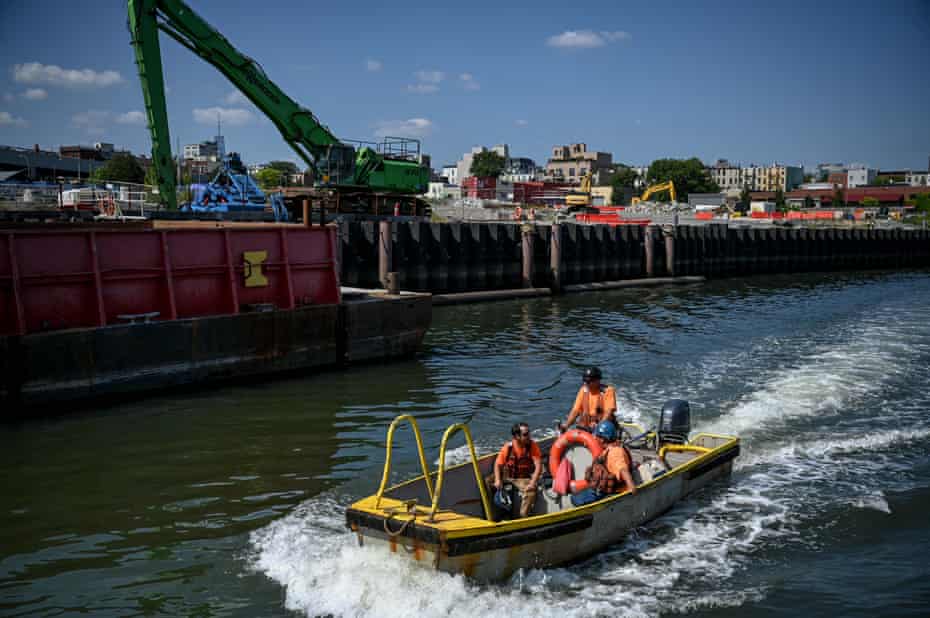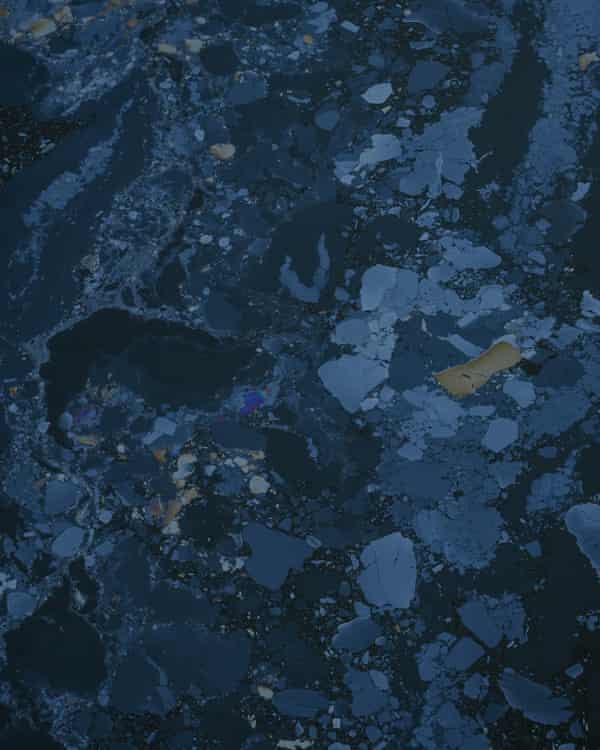Could New York’s ‘black mayonnaise’ problem sink a new 82-block development?

There’s a century of toxic sludge hiding in the Gowanus Canal, but it may not be enough to stop a mega-developer from building on it
In November, gigantic yellow excavators began scooping up the poisonous sludge colloquially known as “black mayonnaise” from the Gowanus Canal in Brooklyn, New York – a momentous step in a prolonged cleanup effort, 10 years after the waterway’s designation as a Superfund site.
But the mood is bittersweet. Longtime residents who campaigned for the Superfund label say they are now facing another environmental battle: a proposed mega-development in the neighborhood that would sit on top of a century’s worth of toxic chemicals.
The project pits residents and city leaders with competing visions for the future of the neighborhood against each other. City officials say the Gowanus neighborhood plan would bring much-needed affordable housing and other public amenities to an area that has rapidly gentrified over the years.
But activists are concerned that development along the flood-prone, polluted waterfront could threaten the ongoing cleanup of the canal – as well as the health and safety of the people who live there.
“It’s disconcerting that public officials are so hellbent on building housing on this very dangerous site, instead of finding creative ways to meet affordable housing goals elsewhere in the area,” said Brad Vogel, a member of the neighborhood coalition Voice of Gowanus and one of the rezoning’s most vocal opponents.
Many residents are fed up with the pace and scope of the cleanup plan, calling it ineffective. In a statement provided to the Guardian, the New York state department of environmental conservation said the agency is providing “strict oversight” of the cleanup of the site in order “to ensure for the strongest protections possible for public health and the environment”.
“The remedy is designed to protect future occupants of the site, the community, and to prevent further releases of contamination to the Gowanus Canal,” it said.
If the city council approves the plan to rezone an 82-block swath of the Gowanus Canal waterfront, developers would get the green light to construct thousands of residential apartments, as well as shops, restaurants and other businesses, along the Superfund site. Despite community pushback, Mayor Bill de Blasio is plunging ahead with the controversial plan before the sun sets on his administration at the end of the year.

On the surface, the proposal to rezone the neighborhood’s industrial past sounds like a win: the plan’s main attraction is Gowanus Green, a six-building campus that would include 950 affordable housing units, a public park and a school.
It also includes a plan to improve shoreline resiliency and a greener urban canopy – which would make the waterfront more accessible.
But a growing group of activists, residents and legislators say the development’s stylish packaging amounts to “greenwashing” – the practice of touting superficial environmental upgrades to cover up a continued commitment to pollution.
The city-owned lot where developers seek to build their affordable housing complex and public school has a dirty history: an ocean of coal tar – a toxic byproduct of gas production found all over Gowanus.
This black, viscous liquid has been found at the proposed development site at depths of up to 153 feet. Because coal tar moves under the force of gravity, it can spread in soil and groundwater. “Coal tar resists degradation for geologic time,” said Allen W Hatheway, a Missouri-based geological engineer and an expert on manufactured gas plants. “Once it gets in the ground, it’s always a bad situation.”

Hatheway characterized coal tar as a “witch’s brew” of hundreds or thousands of cancer-causing chemicals such as benzene and naphthalene.
The source of the coal tar was the Citizens Gas Works plant – which was the largest in the country when it opened along the canal in 1861. Over the next 150 years, the canal morphed into a repository of untreated industrial wastes, raw sewage and stormwater runoff, as more gas plants, paint and ink factories, tanneries and other industries opened next door.
By the 1950s, the availability of cheaper, cleaner natural gas caused most manufactured gas plants – or MGPs – to shut down. In the 60s, the Citizens Gas Works plant was decommissioned and later seized by the city. But the coal tar has stuck around – sheens of coal tar are a common sight on the surface of the canal. Two other former MGPs are situated along the canal, and sometimes it’s difficult to tell where the tar contamination from one site ends and the next begins, according to reports from the state DEC.
Coal tar is hazardous to human health if a person ingests or comes into contact with it through contaminated soil or groundwater. Fumes from the chemicals also pose a risk if people breathe them, said Hatheway, and the plan to build affordable housing and a public school on top of the contamination intensifies the chance of this happening.
Leaving pools of tar underground is hardly a permanent solution. Increased rainfall and rising sea levels could also spread contaminants further into the neighborhood. It’s also possible that over time, coal tar left underground will volatilize – or convert into vapor – and migrate into buildings, causing cancer or damage to the liver, kidneys and central nervous system, according to the EPA. Cracks in the floor or normal wear and tear over time exacerbate this risk.
Given these health and environmental risks, critics say building housing in the area is a dangerous gamble.
“The amount of coal tar that’s in the ground there is enormous,” said Joseph Alexiou, a local historian and the author of Gowanus: Brooklyn’s Curious Canal. “We’re talking about an environmental disaster that the city and the state are downplaying, so that they can build a really big, luxury development.”
The company that owned the Citizens Gas Works plant later became part of what is now National Grid.
In 2008, the Bloomberg administration handpicked a consortium of developers to bring Gowanus Green to life as part of a plan to revive the blighted plot of land, with National Grid to undertake the cleanup through the state’s brownfield program.
A few years later, in 2014, the EPA tasked the utility company with cleaning the soil of upland sites along the canal, including the former MGP sites.
But frustrated community members allege the current remediation effort is not only decades overdue but also falls short of the full-scale cleanup they were promised. This, all while developers seeking to build in the area receive tax credits.
After a decade of proposals and public meetings, National Grid’s cleanup plan was approved in 2018. The current cleanup plan calls for excavating up to 22 feet of soil in areas near former MGP structures, where pollution is heaviest, and adding two feet of clean topsoil across the remainder of the site. It also includes an underground barrier wall to be constructed along the canal, to keep contamination from seeping into the waterway, as well as recovery wells that will collect coal tar that accumulates behind the wall.

But some activists say older versions of the cleanup plan included more robust environmental protections. At one point, wing walls – extensions of the underground barrier wall – were considered. A waterproof plastic liner, placed under the eight feet of new soil, was also wiped from the cleanup plan.
Some residents are also concerned that two feet of new topsoil – or “cover system” -won’t be sufficient; the original remedy required a site-wide excavation of all contaminated soil, up to eight feet deep. Much of the coal tar is located at depths between seven and 150 feet, according to National Grid’s remedial investigation.
According to the state DEC, a few factors informed the current cleanup plan. Additional studies into the MGP site found wing walls were redundant additions to the barrier wall and recovery wells, and the plastic liner was eliminated because stormwateris not expected to come into contact with the coal tar pollution left deeper underground. Finally, the site-wide excavation to a depth of eight feet was eliminated because additional study found coal tar contamination was limited to areas near former MGP structures, where deeper excavations are taking place.
Jack Riccobono, a member of Voice of Gowanus, says the latest remediation plan was developed without any public hearing, public comment period or explanation of the state DEC’s decision.
The state DEC maintains the cover system is an addition to the original remediation plan, not a subtraction, and was considered a minor change to the remedy that did not require public comment. The agency also noted the final design has been presented at various public sessions since 2019. But concerned community members are adamant these changes were not made sufficiently clear to them.
Christos Tsiamis, the EPA’s lead engineer on the Gowanus Superfund cleanup, has echoed residents’ concerns. In a community meeting last year, he warned that coal tar vapors could endanger the health of future inhabitants unless better protections were installed. And Tsiamis has said he “wasn’t very pleased” when he noticed the new design had eliminated the wing walls and plastic liner.
“If you put a structure like a school or a building, those compounds that are eight, 10, 15 feet down, they will volatilize,” said Tsiamis. “It might be in five years, it might be in 10 years, they will find a path and they will come inside the enclosed structure and they will build up.”
He later admitted he would not want to live there himself unless more was done to clean up the site and prevent the coal tar vapors from breaching the surface.
Many Gowanus residents consider the Greek engineer to be a rare kind of guardian angel in their fight for environmental justice – an official who is upfront with them.
The DEC’s director of environmental remediation, Michael Ryan, has accused Tsiamis of spreading misinformation, calling his statements “flippant” in a letter to the EPA and demanding the agency disavow his remarks.
But at a community meeting in late March, Tsiamis held firm. He noted that responsible engineering can effectively mop up the site’s contamination, but told community members, “I have not seen any new data or documents since I last spoke to you.”
Cleanups along the canal have been criticized for falling short in the past.
In 2011, half a mile away from the former site of Citizens Works, federal investigators found coal tar oozing under the parking lot of a Lowe’s home improvement store, where another former gas plant had once operated. Before the Lowe’s opened in 2004, the state DEC had cleaned up the site. DEC spokesperson Michael Bop said at the time, “There may be more [pollution] there, but we went down 20-plus feet … We felt that was satisfactory in this situation.” Federal officials said they didn’t excavate deep enough to remove all the contamination.
So when it comes to site remediation, just how clean is clean? Jack Caravanos, an environmental health expert at New York University’s School of Global Public Health, compared it to doing laundry.
“You wash your sweater in some Woolite and you squeeze it and soap comes out. And then you rinse it again and again. At what point do you want to see absolutely no soap?”
Caravanos says this “back and forth” debate is common with toxic waste sites, because the cleanup becomes more expensive the deeper you dig. Any remediation effort warrants a cost-benefit analysis, he said.
But experts generally agree that shortcuts during the remediation process may come at the expense of human health. Caravanos agrees that in Gowanus, the plan to cover parts of the cleanup site with two feet of fresh topsoil doesn’t go far enough.
He also points out that children are at an especially high risk when it comes to potential exposure to contaminants – which raises concerns for the city’s plan to build a public school along the canal.
Some longtime residents worry the prolonged presence of coal tar in the neighborhood has adversely affected people’s health.

Marlene Donnelly, a member of the activist group Friends and Residents of Greater Gowanus, which fought for the canal’s Superfund designation, said cancer cases seemed prevalent in the neighborhood, so much so that it came up regularly as a topic of conversation. “When we were having our block parties, we would talk about whose cancer was in remission, whose wasn’t,” she said.
Though the state department of health has not traced any illnesses to the pollution from the former MGPs, there have been no health studies to determine long-term health effects in the area.
In April, a new study found a clear correlation between living near a Superfund site and lower life expectancy.
The rezoning’s opponents have garnered crucial support from local lawmakers: on 21 May, council member Brad Lander, along with state senator Jabari Brisport, assembly member Jo Anne Simon, and congresswoman Nydia Velazquez signed a letter calling on the federal EPA to weigh in on the proposed development plan, to ensure it wouldn’t jeopardize the ongoing Superfund cleanup. Velazquez also called on the Army Corps of Engineers, the EPA and Fema to look into the city’s environmental impact statement for the mega-development.
Voice of Gowanus has also said they had met with representatives from the New York senator Chuck Schumer, whose environmental team is currently developing a stance on the cleanup plan and proposed development. (Schumer’s office did not respond to the Guardian’s request for comment.)
In a statement to the Guardian, a department of city planning spokesperson, Joe Marvilli, said the agency had “worked with federal, State and City agencies on the cleanup” and “look[s] forward to further discussions” of the plan during public review.

The developers behind Gowanus Green recently entered the state’s brownfield cleanup program and plan to initiate a second remediation after National Grid completes the first phase of targeted cleanup. But this doesn’t sit well with residents who allege the city and state agencies have slow-walked and mishandled environmental justice in Gowanus too many times to be taken seriously.
On 20 August, community members petitioned the EPA to conduct its own environmental assessment of the Citizens Gas Works site in hopes it will qualify for placement on the national priorities list under the Superfund program.
“The city literally just started cleaning up Gowanus and it’s going to take at least 10 years for them to finish,” said Riccobono, from Voice of Gowanus. He said the push to complete “this huge rezoning before they’ve even taken the first step to try to repair the legacy of environmental damage is incredible”.
